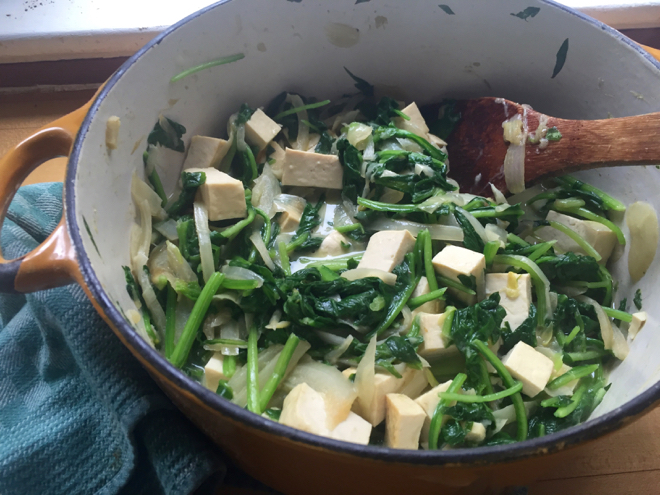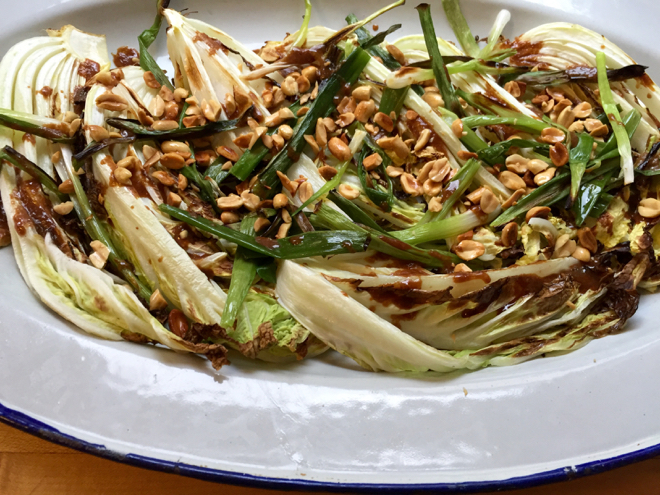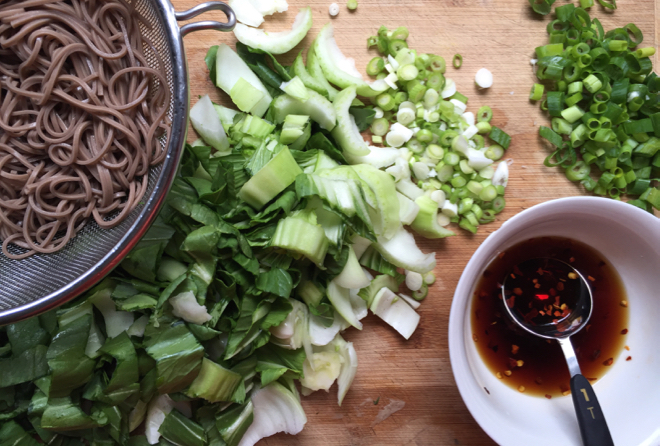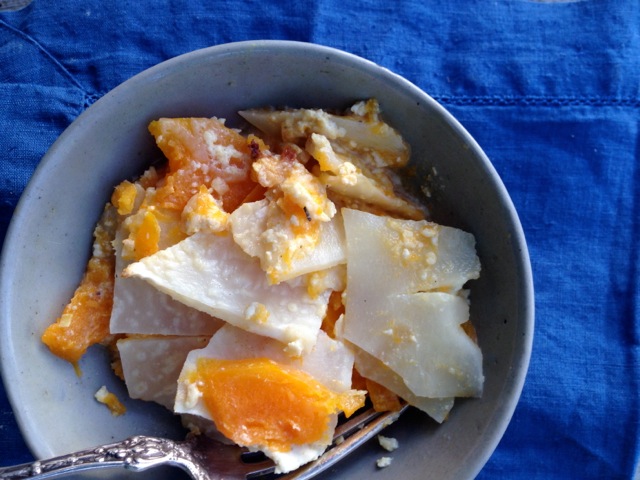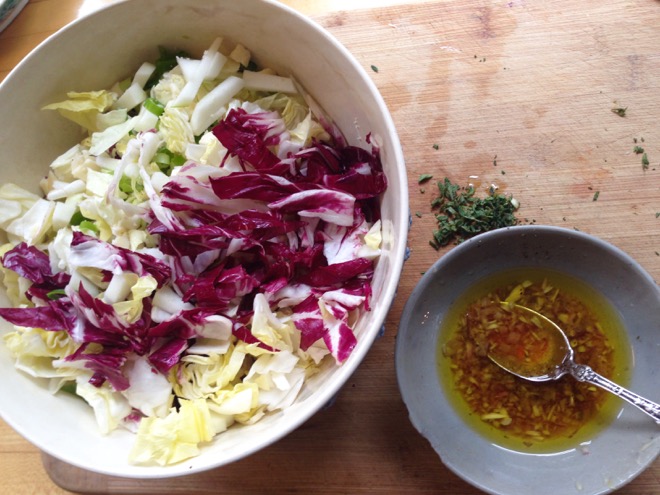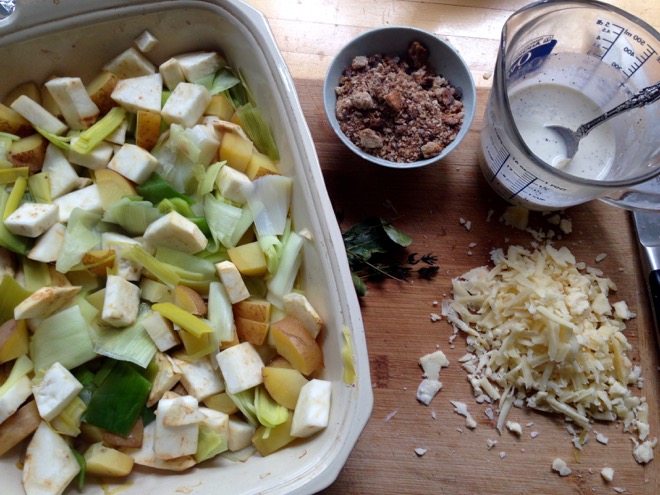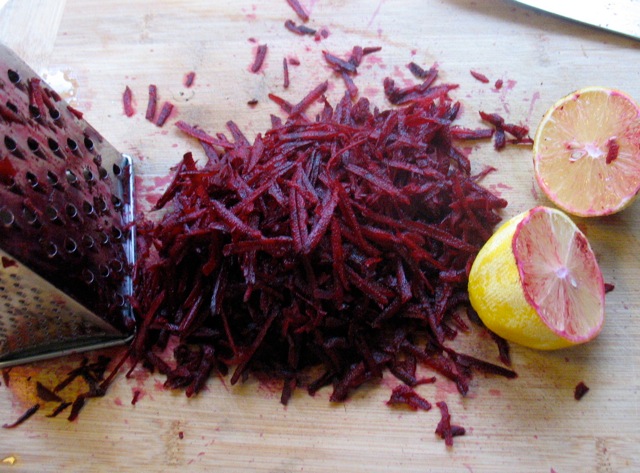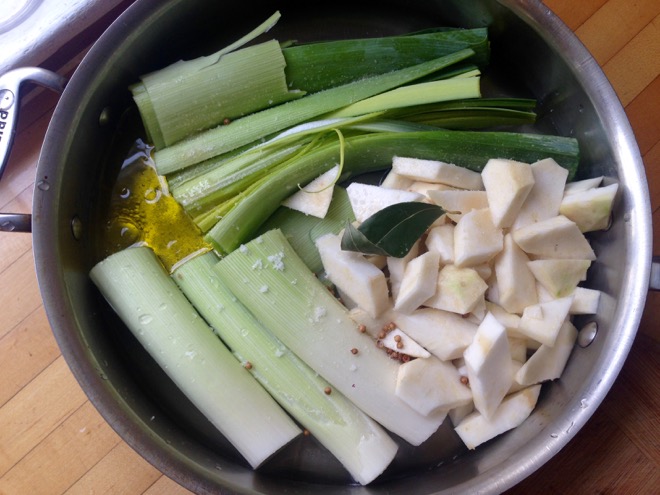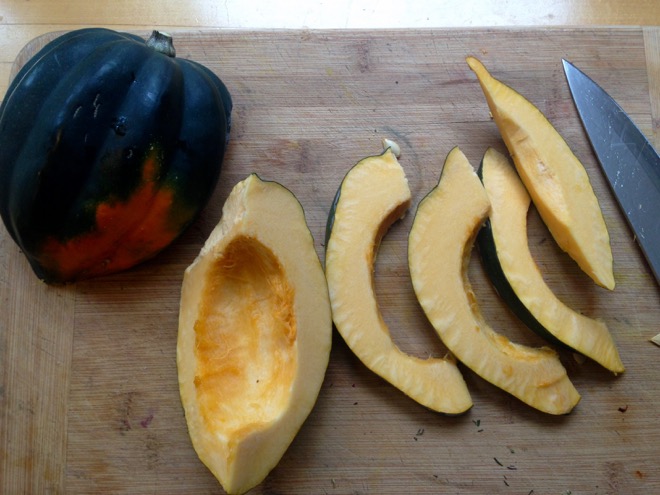The giant radishes are sweet, tender and crunchy this week. Add them to any salad, snack on them as is or mix them with some thinly sliced green onions, a bit of rice wine vinegar, a squeeze of lime juice, salt and splash of oil, for a bright garnish for roasted meats, tacos, grain dishes, with sesame noodles, etc.
Dry Red Curry Broccoli w/ Toasted Peanuts
Green Salad with Potatoes and Creamy Basil Dressing
Braised Fennel with Capers, Garlic and Tomatoes
Spicy Chickpea, Red Cabbage and Carrot Salad
Braised Red Cabbage
Simple Slaw with Radishes and Scallions
Dry Red Curry Broccoli w/ Toasted Peanuts
Quick, delicious, adaptable. Use cauliflower or sweet potatoes or winter squash or even just potatoes and onions. Add what I call “cheesy” toast–any bread toasted, buttered and topped with cheese of choice and broiled until bubbly–and call it dinner.
Serves 4
2-3 tablespoons oil, olive, peanut, coconut or whatever you have
1/2 large onion, thinly sliced
2 cloves garlic, minced
2 scallions (optional), chopped
2-3 teaspoons red curry paste (or more if you like a lot of heat–spice level also varies from brand to brand)
1 1/4 lbs broccoli, stems peeled and chopped and florets chopped into bite-sized pieces
Salt
1/2 cup dry-roasted peanuts
Heat about half the oil in a large, heavy skillet over medium high heat. Add the onions, garlic, scallions (if using) and curry paste and stir well and cook, stirring often for about 3-4 minutes. Be careful not to burn the vegetables. Add the broccoli, a few pinches of salt and possibly the rest of the oil if things look dry. Stir well and cook, covered, stirring often for about 5-7 minutes until the broccoli is tender but still has a little bite.
While broccoli is cooking, toast the peanuts in a small skillet in a little oil and a sprinkling of salt (unless already quite salty). Toast until deeply golden brown, about 7 minutes. Remove from pan, let cool and roughly chop.
Taste broccoli and adjust with salt. Serve with toasted nuts.
I like mixing diced boiled potatoes with a green salad and a creamy dressing. I make many variations but Batavian, Escarole, frisee or other more robust lettuces hold up particularly well here. You probably won’t need all the dressing for this salad. It keeps well for a few days so save for future use. And the tomatoes are completely optional.
Green Salad with Potatoes and Creamy Basil Dressing
I love to mix boiled potatoes into green salads, either with vinaigrettes or creamy dressings.
Serves 4-6
8 cups lettuce, well washed and dried and cut into ribbons (Batavian, Escarole or other more substantial lettuces are very good here as is arugula or any other kind really)
3-4 medium potatoes, boiled and cooled and cut into medium dice
2 green onions, tops included, thinly sliced
Dressing:
Scant 1/2 cup Greek yogurt
2 tablespoons mayonnaise
1 tablespoon good olive oil
1/2 cup thinly sliced basil
Juice of ½ a lemon, more to taste
1 large clove garlic, minced or pressed
Salt and plenty of freshly ground black pepper, to taste
Toss about 2/3 of the dressing with the lettuce, potato, tomato, if using, and onion. Taste, adjust, add more dressing. . . Enjoy!
Braised Fennel with Capers, Garlic and Tomatoes
This is richly flavored and quick to make. Enjoy it with a few salads for a light dinner or alongside any meat or fish or egg dish. I made this dish with just one fennel bulb last week and it was worth making. Just scale everything down a bit . . . it’s quite a forgiving dish.
Serves 4
2-3 tablespoons olive oil
2 fennel bulbs, trimmed and cut top to bottom into 1/2-inch planks
Salt
1/2 onion, diced
2 cloves garlic, minced
2 tablespoons capers, well rinsed and chopped up a bit
2 tablespoons white wine or cider vinegar
1 teaspoon sugar
3/4 cup chopped tomatoes, fresh, roasted or canned (roasted will impart the richest flavor but all are good)
Chopped fennel fronds for garnish, optional
Heat the olive oil in a large, heavy skillet over medium-high heat. When oil is hot add the fennel slices in a single layer–they will likely not all fit. Sprinkle with salt and cook, covered, keeping the heat fairly high, for about 3-5 minutes until nicely browned. Flip and cook for another couple of minutes until the other side is browned as well. Remove from the pan and set aside and finish cooking the remainder of the fennel.
Once cooked, add all the fennel back to the pan, then add the garlic, capers, onions, vinegar, sugar and cook, uncovered, stirring often for about 3 more minutes. Add the tomatoes and turn the heat up a bit more. Cook, for another 3-5 minutes until the tomatoes have reduced and have nicely glazed the fennel. Taste, adjust seasoning, garnish with chopped fennel fronds and serve hot or warm.
Spicy Chickpea, Red Cabbage and Carrot Salad
I try to have cooked beans and chickpeas in the freezer at all times. I cook a good amount, 1 1/2-2 lbs, at a time and then refrigerate and/or freeze portions for future meals. It’s just like having canned beans in the pantry but I’ve gotten so hooked on the flavor and texture of home-cooked ones that I’ve got a good routine in place that takes little effort.
This bright, hearty salad can be adapted to suit your tastes and pantry. Any kind of cabbage would be great, any kind of radish and even other beans. And if you don’t have kimchi, add some chopped pickles or capers to give it depth. By all means add some toasted peanuts or any seed or nut you have and parsley, mint or cilantro for even more color and texture and flavor.
Serves 4
2 cups chickpeas, drained well
3 cups red cabbage, shredded (or other kind of cabbage–see headnote)
3 radishes, trimmed and cut into match sticks
2 medium carrots, scrubbed and cut into matchsticks or grated on the large hols of a box grater
1/3 cup kimchi, chopped (or any pickle you have or 1 1/2 tablespoons capers, rinsed and chopped up a little)
1 1/2 tablespoons cider vinegar
3 tablespoons oil, olive, sunflower, etc.
1/2 Serrano pepper, including seeds, minced or 1/4 teaspoon red pepper flakes
Salt and freshly ground pepper
Put the chickpeas, cabbage, carrots and radishes in a large bowl. Add the kimchi (or alternative) and the dressing ingredients and toss well. Taste and adjust seasoning. You want a good kick of heat and acidity.
Braised Red Cabbage
This is a pretty classic, German-style braised red cabbage dish. It becomes tender and very fragrant with the spices and wine with plenty of acidity. It’s wonderful with mashed potatoes and any roast meats or or grains of any kind. And with the rain and cooler temperatures this week it just might be perfect!
serves 4-6
2 tablespoons butter or olive oil
1 small onion, peeled and thinly sliced
1 medium (2 1/2 pounds) red cabbage, quartered, core removed and thinly sliced
2 teaspoons caraway seeds
1 tablespoon yellow mustard seeds (optional)
1/4 cup cider vinegar
2/3 cup dry red wine
1 large tart apple, peeled and coarsely grated (optional)
Salt and freshly ground black pepper
Melt the butter in a large sauté pan over medium heat. Add the onions and sauté until softened, about 5 minutes. Add the cabbage and mustard and caraway seeds and toss until the cabbage begins to wilt, 2 to 3 minutes.
Add the vinegar, wine and apple. Stir to combine, and season with salt and pepper. Cover the pot, leaving just a crack open. Simmer until the cabbage is soft, about 45 minutes. Adjust salt and pepper, and serve.
Simple Cabbage Slaw with Radishes and Scallions
If you get one of the pointy green cabbages you could make this simple slaw. The cabbage is so sweet and tender it will be perfect here. And could make it with red cabbage too or a mixture of the two.
Serves 4+
About 8 cups thinly sliced or shredded cabbage
1 cup radishes, cut into matchsticks or small dice
2-3 green onions, greens too, thinly sliced
1/2 cup cilantro or parsley, chopped and/or ¼ cup chopped mint (optional)
Dressing:
Juice of 1 ½ – 2 limes or 2+ tablespoons white wine or apple cider vinegar, more to taste
2 teaspoons Dijon-style mustard
3 tablespoons olive oil
3-4 tablespoons Greek yogurt or sour cream or mayonnaise
1 teaspoon ground cumin (optional)
Several pinches red pepper flakes or a small hot pepper like Serrano or Jalapeño, minced (or more if you like heat)
Salt and freshly ground black pepper
Put the vegetables in a large bowl. Mix the dressing ingredients in a small bowl. Add 2/3 of the dressing to the cabbage and mix well. Taste and ad more dressing, as needed.








